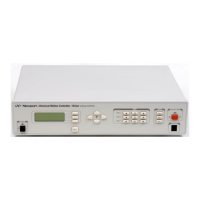Due to such physical attributes, a significant position error can be
generated when systems are moved from one position to another by
stepper motors without any closed loop control mechanism. This error
can be further accentuated by micro-stepping and non-collection of
encoders (necessary to have closed loop control) and motors. ESP
series of motion controller's support closed loop positioning of
stepper motors to eliminate such errors.
The next subsection details the implementation of this feature in ESP
controllers.
4.3.2 Feature Implementation
While closed loop control of stepper motors can be done during
tracking as well as regulation, ESP controllers' closed loop stepping
feature is effective only during regulation, i.e., desired motion is
completed and the motor is holding position. This was done in order
to avoid tuning of control gains such as proportional (Kp), integral
(Ki), derivative (Kd) gains, etc. Users need to only enable the feature
and define two (2) parameters – desired deadband and closed loop
update interval.
The following block diagram illustrates this feature. When the desired
motion is completed, the controller calculates position error and
evaluates if the error is within the user-specified deadband. If it is, no
further corrective actions are commanded. On the other hand, if the
error is larger than the desired value, the controller starts the closed
loop update interval timer and issues commands to make necessary
corrections.
It- then, waits for the timer to reset before checking the position error
again. This process is repeated until the position error reduces to the
desired value (deadband). The corrective actions taken by the
controller to reduce positioning error are dependent upon the way in
which the stepper motors are controlled: digital (pulse generation) or
analog (sinusoidal commutation).
In case of digitally controlled stepper motors, new corrective move
commands are internally issued by the controller. In the case of
Commutated stepper motors, the electrical angle is adjusted.
4-10 Section 4 – Advanced Capabilities

